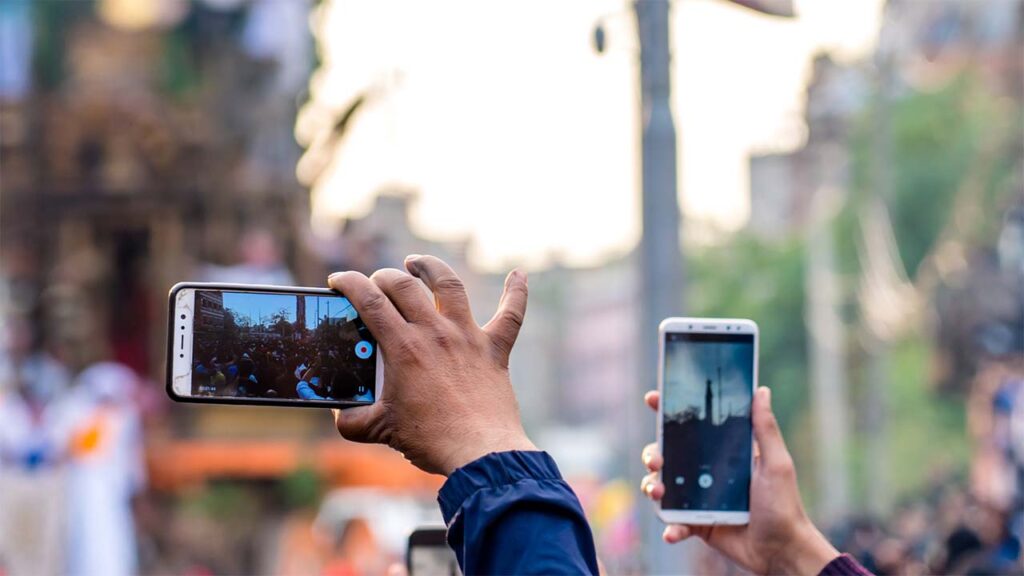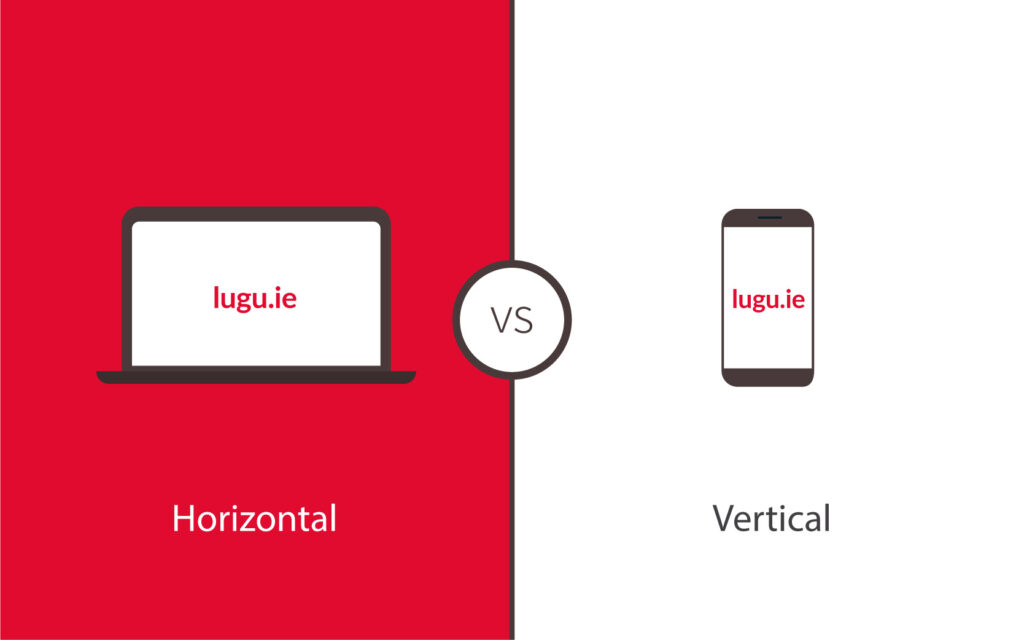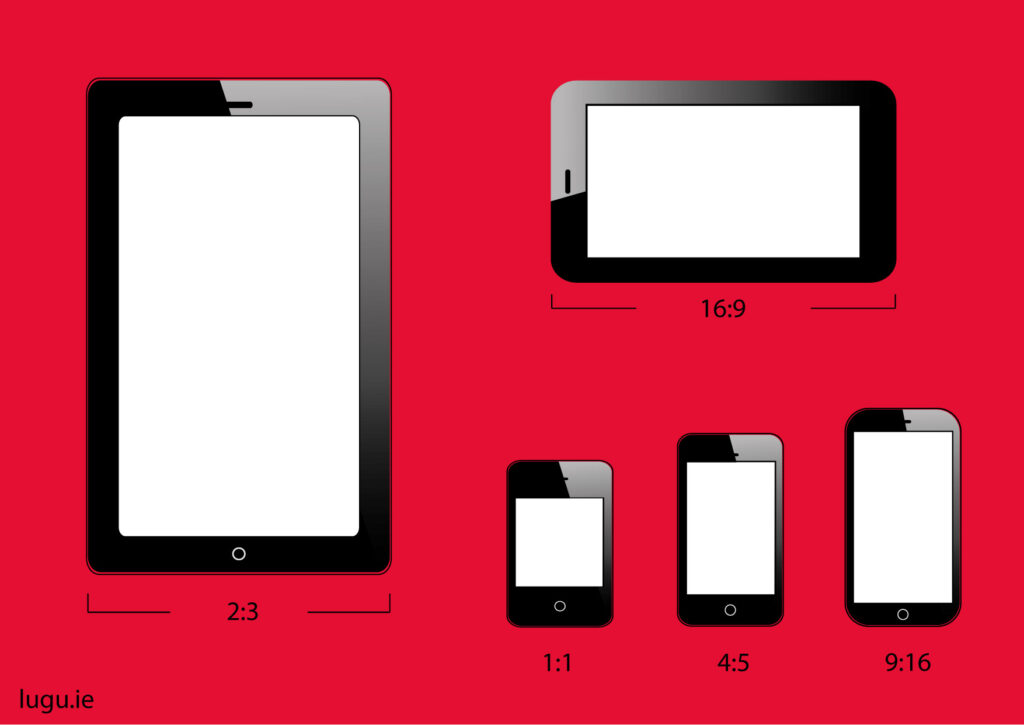Video orientation
Horizontal orientation originates from cinema and was later adopted in television. Horizontal videos make lots of sense because of human anatomy, and maximising area of footage exposure to both eyes. However, improvements in smartphone cameras, mobile internet and rapid growth of social media have introduced new ways of content production, as well as how we consume pictures and videos. Mobile access to the internet via smartphones has made it the main way to watch and produce visual content for the internet based on the way we usually hold smartphones – vertically.
What is the aspect ratio?
Orientation on its own determines how we see the frame, horizontally or vertically. But aspect ratio controls how wide or high the frame is. Technically speaking an aspect ratio in terms of video, pictures or graphics, is a proportional relationship between picture width and height. It means that, for a hypothetical width of 16 inches (or cm/pixels), our picture would need to be 9 inches in height. This makes the aspect ratio 16:9.
Just keep in mind that the actual size/ resolution of the picture doesn’t really matter here. Both resolution sets HD (1280×720) and Full HD (1920×1080) represent this same aspect ratio of 16:9. The most important is the proportion between width and height. Depending on the aspect ratio, we visually see it as a wider or higher frame. For example, aspect ratio 1:1 means a square picture (the same width and height), which nowadays is quite popular on social media, especially on Instagram.
Horizontal aspect ratio
Do you remember the time of tape camcorders and heavy television sets? SD resolution with poor-quality images was what we could get. The SD resolution, which was used in televisions, also makes the 4:3 aspect ratio. This is how most of our old-school television sets were constructed.
HD and Full HD resolution was a big revolution in picture quality offered by television. Except for much higher resolution, HD and Full HD resolution also offered wider frame and this is where the very popular 16:9 aspect ratio originates. It is applied to most of the digital video cameras, camcorders and modern television sets we use today. Because this is the main video format in most cameras, the 16:9 ratio is still used in social media, YouTube etc.
Other horizontal possibilities worth mentioning are the widescreen aspect ratios used to achieve a cinematic look. The proportion of 2.35:1 is one of the more popular choices for widescreen, but there are many other choices. What is important, is that horizontal videos are still a popular option. Even in social media, they are utilised quite often and they make our content look more prestigious.
Vertical aspect ratio
It is not a secret that nowadays most content (including video) is consumed by people using their smartphones, usually outside of the home. We prefer browsing rather than consuming entire content, especially using social media. A natural way of browsing a feed or FB wall is to hold a phone vertically. This is also how people tend to record videos using smartphones. Despite the obvious possibility of rotating smartphones to watch videos horizontally at full width and height, most consumers do not do that, especially when using social media.
Even when something grabs our attention, we tend to quickly jump back into browsing. This trend was caught by brands and marketers. Today more and more promotional content on social media is produced to match smartphone users. The obvious vertical aspect ratio (originates from how we hold phones) is 9:16. It is the most popular solution in producing content, and only actually possible in the context of creating stories on Instagram, Facebook or Snapchat. However, for videographers who are using camcorders and cameras, this is a problematic approach (as professional video equipment records videos horizontally).
Why is the 4:5 aspect ratio so cool?
The vertical 9:16 aspect ratio is the best solution for people still consuming social media content on mobile devices like smartphones or tablets. Options which are better for our anatomy, less drastic, and not cropped on news feed are 2:3 (Facebook only) and 4:5 aspect ratios.
My favourite option for social media video is 4:5. Why is the 4:5 aspect ratio so cool? The 4:5 aspect ratio provide us with a wider frame, during the process of transforming horizontal video from professional cameras into vertical, we lose less information. What is even more important some social media platforms will actually crop the view of vertical 9:16 videos while scrolling through the feed (e.g. Instagram). This will not happen with 4:5 videos.
Square aspect ratio
Another great compromise between smartphone users and traditional horizontal graphic formats is a square aspect ratio (1:1). As a videographer, I often struggle between producing suitable content for smartphone users, whilst at the same time using all the advantages of recording by professional camcorders or cameras. Recording in a 16:9 aspect ratio and converting it later into a vertical version means losing huge parts of a frame (and information). The square aspect ratio is also closer to how we get used to watching videos – horizontally.
Finding the best video aspect ratio depends on many factors including the platform, target group and camera we use. If you would like to know how to choose the video format and best aspect ratio for your social media channels, or follow our profile on LinkedIn or check our blog. More in-depth guide about choosing aspect ratio for social media available soon!



